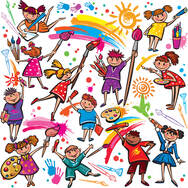
Dr. Nomi Sheppard received her doctoral degree in Education from Stanford University and currently serves as Executive Director for Soulfood Studios. As an administrator, educator and parent volunteer in the public school system in rural Nevada and rural Utah, her many years of experience revealed a dearth of expressive arts opportunities for rural youth in and out of school. She initially founded Soulfood Studios in 2012 and received 501(c)(3) status in May of 2015. See my list of former and current board members & volunteers.
Program monies received:
- 2016 Nevada Circuit Riders Grant, Nevada Arts Council with consultant Suzanne Hackett-Morgan
- 2016 Artist Residency Express Grant, Nevada Arts Council with Jason Nious
- 2017 Self-funded Art Camp
- 2017 Art Booth funded by donations from the Snake Valley Scholarship Fund
- 2017 Facebook donations for Art Camp 2018
- 2018 Art Camp donation, Snake Valley Scholarship Fund
- 2018 Facebook donations, Art Camp donations, Retreat donations
- 2018 Artist Residency Express Grant, Nevada Arts Council with Jason Nious & Molodi Arts Education
- 2019 Art Camp, Art Booth, Healing Retreat donation, Snake Valley Scholarship Fund
- 2020-2021 Moore-Joy project: land donation - Adrienne Joy, old post office repairs - Dave & Roberta Moore (activities cancelled due to coronavirus)
- 2021 Nevada GOED PETS Grant, Snake Valley Scholarship Fund, Nevada Arts Council American Rescue Plan (ARP) Grant for Organizations
- 2022 Nevada Arts Council Operating Support Grant, Kaiser Foundation Employee Engagement Program
- 2023 Nevada Arts Council Operating Support Grant, Kaiser Foundation Employee Engagement Program
- 2024-2025 Nevada Arts Council Operating Support Grant
Soulfood Studios has provided mobile arts opportunities and will continue to organize artists' residencies and workshops for youth in local elementary and high schools as well as the greater community of Snake Valley (residents and visitors alike). A small art studio space was completed in the summer of 2019. Soulfood Studios was gifted two Downtown Baker lots in summer of 2020. In 2021 an old post office in Baker has been converted into Soulfood Studios. A new roof, electricity, siding, windows & doors have been installed. Funding for water & sewer has been secured! A licensed plumbing contractor installed a new service connection in Spring of 2024. Once water and sewer can be brought to the buildings we will be in full operational mode!
Dr. Sheppard has been deeply inspired by the ideas espoused in MaryAnn F. Kohl's 'Process Art'.
In her 2015 article on Fostering Creativity Kohl references "James D. Moran III, Dean of the College of Human Ecology at the University of Tennessee, [who] suggests that teachers:
- Emphasize process rather than product.
- Provide a classroom environment that allows children to explore and play without undue restraints.
- Adapt to children’s ideas rather than trying to structure the children’s ideas to fit the adult’s.
- Accept unusual ideas from children by suspending judgment of children’s divergent problem solving.
- Use creative problem solving in all parts of the curriculum. Use the problems that naturally occur in everyday life.
- Allow time for children to explore all possibilities, moving from popular to more original ideas."
Kohl also concludes,
|
"Teachers who respect children’s ideas
help them learn to think and solve problems for themselves. |
Grant the lasting gift of freedom to children –
to make mistakes and learning from doing. |
|
Children who feel free to make mistakes and
to explore and experiment will also feel free to invent, create, and find new ways to do things. |
The side benefit is that fostering creativity in our classrooms
makes teaching more rewarding and fun and gives children a zest for imagining and learning to last a lifetime." |
(http://brightring.com/about-creativity/fostering-creativity/)

Dr. Sheppard was also influenced by the works of Professor Elliot Eisner while studying with him at Stanford's School of Education.
His arts philosophy can be embodied in his, 10 Lessons the Arts Teach:
- "The arts teach children to make GOOD JUDGMENTS about qualitative relationships. Unlike much of the curriculum in which correct answers and rules prevail, in the arts, it is judgment rather than rules that prevail.
- The arts teach children that problems can have MORE than ONE solution and that questions can have more than one answer.
- The arts celebrate multiple PERSPECTIVES. One of their large lessons is that there are many ways to SEE and INTERPRET the world.
- The arts teach children that in complex forms of problem solving purposes are seldom fixed, but change with circumstance and opportunity. Learning in the arts requires the ABILITY and a WILLINGNESS to surrender to the unanticipated possibilities of the work as it unfolds.
- The arts make VIVID the fact that neither words in their literal form nor numbers exhaust what we can KNOW.The limits of our language do not define the limits of our COGNITION.
- The arts teach students that SMALL DIFFERENCES can have LARGE EFFECTS. The arts traffic in subtleties.
- The arts teach students to think through and within a material. All art forms employ some means through which IMAGES become REAL.
- The arts help CHILDREN LEARN to say what cannot be said. When children are invited to disclose what a work of art helps them FEEL, they must reach into their POETIC CAPACITIES to find the words that will do the job.
- The ARTS ENABLE us to have EXPERIENCE we can have from no other source and through such experience to DISCOVER the range and variety of what we are capable of FEELING.
- The arts' position in the school curriculum symbolizes to the young what adults BELIEVE is IMPORTANT."*
SOURCE: Eisner, E. (2002). The Arts and the Creation of Mind, In Chapter 4, What the Arts Teach and How It Shows. (pp. 70-92). Yale University Press. Available from NAEA Publications. NAEA grants reprint permission for this excerpt from Ten Lessons with proper acknowledgment of its source and NAEA. To obtain a digital version of this document, please visit www.arteducators.org/advocacy.

